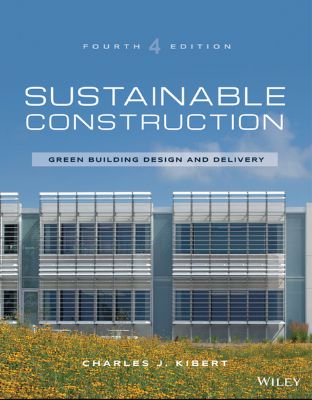
Lýsing:
The leading green building reference, updated with the latest advances in the field Sustainable Construction is the leading reference for the design, construction, and operation of high performance green buildings. With broad coverage including architecture, engineering, and construction, this book nevertheless delivers detailed information on all aspects of the green building process, from materials selection to building systems and more.
This new fourth edition has been updated to reflect the latest codes and standards, including LEED v4, and includes new coverage of carbon accounting. The discussion has been updated to align with the current thinking on economics, climate change, net zero buildings, and more, with contributions by leaders in the field that illustrate the most recent shifts in thinking and practice. Ancillary materials including an instructor's manual and PowerPoint presentations for each chapter help bring this clear and up-to-date information into the classroom, making this book a valuable reference for working construction professionals.
Also, Interactive graphics found throughout the course help activate the content and highlight key concepts for students. Sustainable construction has gone mainstream, and will one day be the industry norm. This book provides a comprehensive reference to all aspects of a project to show you how green building concepts and principles apply throughout the design and construction process. Get up to date on the latest green building codes and standards Learn about the newest technology in green building materials Adopt the best practices in procurement and delivery systems Apply sustainability concepts to all aspects of construction and design Green buildings operate at a very high level of efficiency, which is made possible only by careful consideration every step of the way.
Annað
- Höfundur: Charles J. Kibert
- Útgáfa:4
- Útgáfudagur: 2016-04-11
- Hægt að prenta út 2 bls.
- Hægt að afrita 10 bls.
- Format:ePub
- ISBN 13: 9781119055327
- Print ISBN: 9781119055174
- ISBN 10: 1119055326
Efnisyfirlit
- Preface
- Chapter 1 Introduction and Overview
- The Shifting Landscape for Green Buildings
- The Roots of Sustainable Construction
- Sustainable Development and Sustainable Construction
- The Vocabulary of Sustainable Development and Sustainable Construction
- Sustainable Design, Ecological Design, and Green Design
- Rationale for High-Performance Green Buildings
- State and Local Guidelines for High-Performance Construction
- Green Building Progress and Obstacles
- Trends in High-Performance Green Building
- Book Organization
- Summary and Conclusions
- References
- Part I Green Building Foundations
- Chapter 2 Background
- The Driving Forces for Sustainable Construction
- Ethics and Sustainability
- Basic Concepts and Vocabulary
- Major Environmental and Resource Concerns
- The Green Building Movement
- Summary and Conclusions
- References
- Chapter 3 Ecological Design
- Design versus Ecological Design
- Contemporary Ecological Design
- Key Green Building Publications: Early 1990s
- Key Thinking about Ecological Design
- Evolving the Concept of Ecological Design
- Thermodynamics: Limits on Recycling and the Dissipation of Materials
- Summary and Conclusions
- References
- Chapter 2 Background
- Chapter 4 Green Building Assessment
- Purpose of Green Building Assessment Systems
- Major Green Building Assessment Systems Used in the United States
- International Building Assessment Systems
- Summary and Conclusions
- References
- Chapter 5 The U.S. Green Building Council LEED Building Rating System
- Brief History of LEED
- Structure of the LEED Suite of Building Rating Systems
- LEED Credentials
- LEED v4 Structure and Process
- LEED Building Design and Construction Rating System
- Summary and Conclusions
- Chapter 6 The Green Globes Building Assessment System
- Green Globes Building Rating Tools
- Structure of Green Globes for New Construction
- Green Globes Assessment and Certification Process
- Green Globes Professional Credentials
- Summary and Conclusions
- Chapter 7 The Green Building Design Process
- Conventional versus Green Building Delivery Systems
- Executing the Green Building Project
- Integrated Design Process
- Role of the Charrette in the Design Process
- Green Building Documentation Requirements
- Summary and Conclusions
- Chapter 8 The Sustainable Site and Landscape
- Land and Landscape Approaches for Green Buildings
- Land Use Issues
- Sustainable Landscapes
- Enhancing Ecosystems
- Stormwater Management
- Low-Impact Development
- Heat Island Mitigation
- Light Trespass and Pollution Reduction
- Assessment of Sustainable Sites: The Sustainable Sites Initiative
- Summary and Conclusions
- References
- Chapter 9 Low-Energy Building Strategies
- Building Energy Issues
- High-Performance Building Energy Design Strategy
- Passive Design Strategy
- Building Envelope
- Internal Load Reduction
- Active Mechanical Systems
- Water-Heating Systems
- Electrical Power Systems
- Innovative Energy Optimization Strategies
- Renewable Energy Systems
- Fuel Cells
- Smart Buildings and Energy Management Systems
- Ozone-Depleting Chemicals in HVAC&R Systems
- Summary and Conclusions
- References
- Chapter 10 Built Environment Hydrologic Cycle
- Global Water Resource Depletion
- Water Distribution and Shortages in the United States
- Hydrologic Cycle Terminology
- High-Performance Building Hydrologic Cycle Strategy
- Designing the High-Performance Building Hydrologic Cycle
- Water Budget Rules of Thumb (Heuristics)
- Sustainable Stormwater Management
- Landscaping Water Efficiency
- Summary and Conclusions
- References
- Chapter 11 Closing Materials Loops
- The Challenge of Materials and Product Selection
- Distinguishing between Green Building Products and Green Building Materials
- LCA of Building Materials and Products
- Environmental Product Declarations
- Materials and Product Certification Systems
- Key and Emerging Construction Materials and Products
- Design for Deconstruction and Disassembly
- Summary and Conclusions
- References
- Chapter 12 Built Environment Carbon Footprint
- Human Impacts on the Biogeochemical Carbon Cycle
- Climate Change and the Carbon Cycle
- Mitigating Climate Change
- Defining the Carbon Footprint of the Built Environment
- Reducing the Carbon Footprint of the Built Environment
- References
- Chapter 13 Indoor Environmental Quality
- Indoor Environmental Quality: The Issues
- Integrated IEQ Design
- Addressing the Main Components of Integrated IEQ Design
- HVAC System Design
- Emissions from Building Materials
- Particleboard and Plywood
- Economic Benefits of Good IEQ
- Health, Well-Being, and Productivity
- Summary and Conclusions
- References
- Chapter 14 Construction Operations and Commissioning
- Site Protection Planning
- Managing Indoor Air Quality during Construction
- Construction Materials Management
- Construction and Demolition Waste Management
- Commissioning
- Summary and Conclusions
- References
- Chapter 15 Green Building Economics
- General Approach
- The Business Case for High-Performance Green Buildings
- Economics of Green Building
- Quantifying Green Building Benefits
- Managing First Costs
- Tunneling through the Cost Barrier
- Summary and Conclusions
- References
- Chapter 16 The Cutting Edge of Sustainable Construction
- Resilience
- Cutting Edge: Case Studies
- Case Study: The Federal Building, San Francisco, California
- Excellence in Daylighting
- Natural Ventilation Strategy
- A Flexible and Innovative Interior Strategy
- Articulating Performance Goals for Future Green Buildings
- The Challenges
- Vernacular Vision: Relearning the Past
- High-Technology Approach
- The Biomimetic Model
- Rethinking the Products of Construction
- Revamping Ecological Design
- Today’s Cutting Edge
- High-Performance Building Standards
- The Living Building Challenge
- Environmental Product Declarations
- Carbon Accounting for the Built Environment
- Summary and Conclusions
- Notes
- References
UM RAFBÆKUR Á HEIMKAUP.IS
Bókahillan þín er þitt svæði og þar eru bækurnar þínar geymdar. Þú kemst í bókahilluna þína hvar og hvenær sem er í tölvu eða snjalltæki. Einfalt og þægilegt!Rafbók til eignar
Rafbók til eignar þarf að hlaða niður á þau tæki sem þú vilt nota innan eins árs frá því bókin er keypt.
Þú kemst í bækurnar hvar sem er
Þú getur nálgast allar raf(skóla)bækurnar þínar á einu augabragði, hvar og hvenær sem er í bókahillunni þinni. Engin taska, enginn kyndill og ekkert vesen (hvað þá yfirvigt).
Auðvelt að fletta og leita
Þú getur flakkað milli síðna og kafla eins og þér hentar best og farið beint í ákveðna kafla úr efnisyfirlitinu. Í leitinni finnur þú orð, kafla eða síður í einum smelli.
Glósur og yfirstrikanir
Þú getur auðkennt textabrot með mismunandi litum og skrifað glósur að vild í rafbókina. Þú getur jafnvel séð glósur og yfirstrikanir hjá bekkjarsystkinum og kennara ef þeir leyfa það. Allt á einum stað.
Hvað viltu sjá? / Þú ræður hvernig síðan lítur út
Þú lagar síðuna að þínum þörfum. Stækkaðu eða minnkaðu myndir og texta með multi-level zoom til að sjá síðuna eins og þér hentar best í þínu námi.
Fleiri góðir kostir
- Þú getur prentað síður úr bókinni (innan þeirra marka sem útgefandinn setur)
- Möguleiki á tengingu við annað stafrænt og gagnvirkt efni, svo sem myndbönd eða spurningar úr efninu
- Auðvelt að afrita og líma efni/texta fyrir t.d. heimaverkefni eða ritgerðir
- Styður tækni sem hjálpar nemendum með sjón- eða heyrnarskerðingu
- Gerð : 208
- Höfundur : 12456
- Útgáfuár : 2016
- Leyfi : 380


